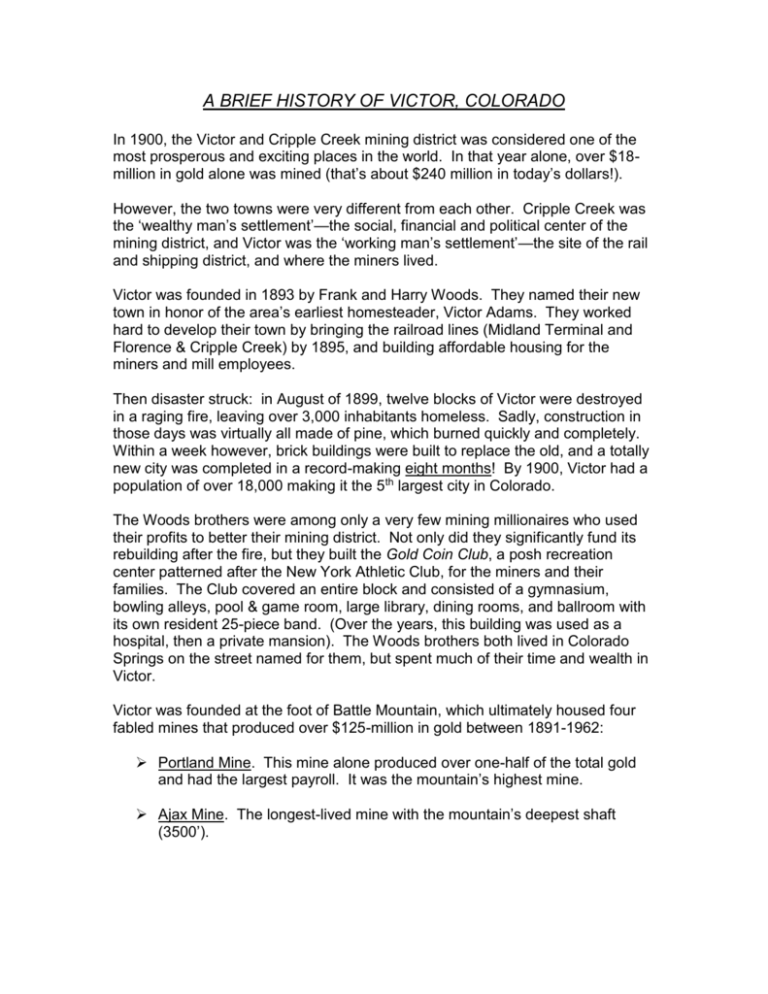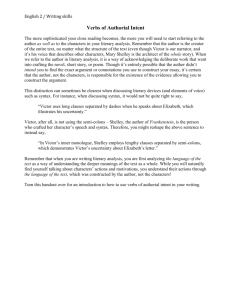A BRIEF HISTORY OF VICTOR, COLORADO
advertisement

A BRIEF HISTORY OF VICTOR, COLORADO In 1900, the Victor and Cripple Creek mining district was considered one of the most prosperous and exciting places in the world. In that year alone, over $18million in gold alone was mined (that’s about $240 million in today’s dollars!). However, the two towns were very different from each other. Cripple Creek was the ‘wealthy man’s settlement’—the social, financial and political center of the mining district, and Victor was the ‘working man’s settlement’—the site of the rail and shipping district, and where the miners lived. Victor was founded in 1893 by Frank and Harry Woods. They named their new town in honor of the area’s earliest homesteader, Victor Adams. They worked hard to develop their town by bringing the railroad lines (Midland Terminal and Florence & Cripple Creek) by 1895, and building affordable housing for the miners and mill employees. Then disaster struck: in August of 1899, twelve blocks of Victor were destroyed in a raging fire, leaving over 3,000 inhabitants homeless. Sadly, construction in those days was virtually all made of pine, which burned quickly and completely. Within a week however, brick buildings were built to replace the old, and a totally new city was completed in a record-making eight months! By 1900, Victor had a population of over 18,000 making it the 5th largest city in Colorado. The Woods brothers were among only a very few mining millionaires who used their profits to better their mining district. Not only did they significantly fund its rebuilding after the fire, but they built the Gold Coin Club, a posh recreation center patterned after the New York Athletic Club, for the miners and their families. The Club covered an entire block and consisted of a gymnasium, bowling alleys, pool & game room, large library, dining rooms, and ballroom with its own resident 25-piece band. (Over the years, this building was used as a hospital, then a private mansion). The Woods brothers both lived in Colorado Springs on the street named for them, but spent much of their time and wealth in Victor. Victor was founded at the foot of Battle Mountain, which ultimately housed four fabled mines that produced over $125-million in gold between 1891-1962: Portland Mine. This mine alone produced over one-half of the total gold and had the largest payroll. It was the mountain’s highest mine. Ajax Mine. The longest-lived mine with the mountain’s deepest shaft (3500’). Independence Mine. Discovered by Winfield Scott Stratton who became the District’s first multi-millionaire; he later sold it to a London company. This mine had over 18 miles of tunnels. Strong Mine. Arguably the best-equipped of all the mines within easy walking distance of downtown Victor. Sam Strong, who discovered this mine, was shot to death in a Cripple Creek saloon. Mention must also be made of the rich ore of the Gold Coin Mine, unexpectedly founded by the Woods brothers right in Victor’s business district as they were digging the foundation of a proposed first-class hotel! Needless to say, plans for a hotel at that site were scrapped and their great mine prospered instead. The Woods brothers also founded the First Baptist Church, First National Bank, Golden Crescent Water & Light Company, and Pikes Peak Power Company (by creating the Skaguay Reservoir and its dam) n/k/a Southern Power. Victor became home to many well-known individuals over the years: (1) Lowell Thomas, graduate of Victor High School, of news and film-making fame, including “Lawrence of Arabia” (we’ll learn more about him at the Museum) (2) Groucho Marx, who worked for a grocer in this area after his traveling show folded in Victor (3) Mabel Barbee Lee, a schoolteacher in Victor, whose books about Cripple Creek’s history became best-sellers (4) Winfield Scott Stratton, the District’s first multi-millionaire, who founded the Myron Stratton Home in Colorado Springs for orphans and the aged as a legacy to his father (5) Edward Gallagher & Al Shean, two early motormen on the District’s trolley system, later co-founded a vaudeville act and made it big in the Ziegfield Follies. After the Ajax Mine closed in 1962, bringing an end to Victor’s golden mining days, there was a dramatic decrease in its population. However, tourism to this well-preserved mining town has steadily increased, and the boom in the price of gold has again made mining (albeit on a much smaller scale) prosperous. Its current population is estimated at 455. Due to its altitude, its winters are colder with more snow than in Colorado Springs, but it has a mild sunny summer.







